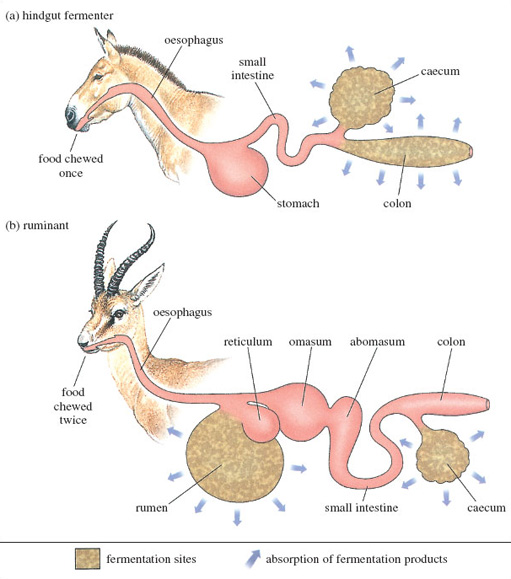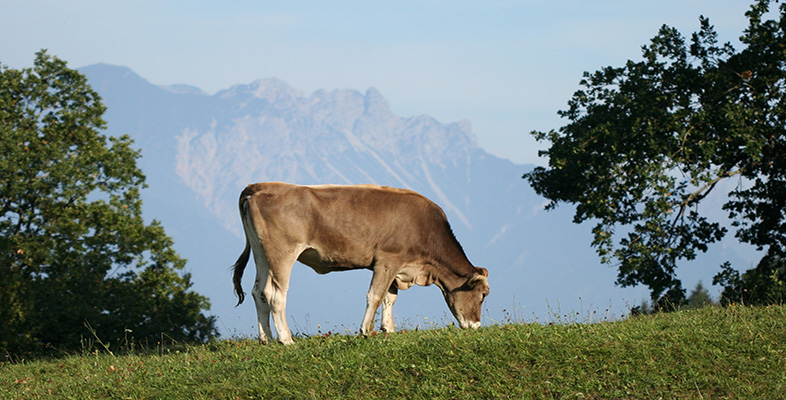4.2 Digesting cellulose
Figure 3 in this section contains a lot of information and many terms that are probably new to you. Set aside the detail for the moment, read the caption and try to get an overall impression. You should see that it shows the digestive systems of two herbivores, simplified and stretched out, rather than being folded up into the minimum space as they would be inside an actual animal. None of the other internal organs of the animals is shown. One of the great benefits of diagrams over photographs or accurate scale drawings is that in a diagram, you can just concentrate on the aspects you want to show and omit all other details. As you read the text, you will be introduced to different aspects of this diagram, so try to glance from the text to the diagram as you meet the various points.

The enzyme needed to digest cellulose is called cellulase. Enzymes are often named like this, i.e. by taking part of the name of the substance that they digest and replacing the end of the word by '-ase'. For example, proteins are digested by types of enzymes called proteases and the sugar in milk, lactose, is digested by the enzyme lactase. Animals that live on plant material have detectable cellulase activity in their digestive systems. However, detailed genetic studies have shown that the vast majority of animals do not possess the gene for making cellulase, so the enzyme is clearly not synthesised by the animal itself. The gene for cellulase does appear to exist in a few animals, namely some insects (such as vine weevil larvae, cockroaches, termites and silkworms), some earthworms, a wood-boring clam, and a fish called the grass carp. This very odd assemblage of creatures has no close taxonomic relationship, indicating that the ability to produce cellulase probably evolved independently several times. Why it has not evolved more frequently is mysterious - it appears never to have evolved in mammals. Mammals that need cellulase have to make use of some additional species that do possess the gene - namely microbes, mostly bacteria and fungi, but also some protoctists (tiny organisms, most of them composed of just a single cell with a nucleus). Parts of the mammal's digestive system are modified to form large sacs where huge colonies of these microbes break down, or ferment, the cellulose.
SAQ 7
Most herbivorous mammals can be placed into one of two groups, according to where in their digestive system the cellulase-producing microbes are housed. Tapirs are members of one group and chevrotains belong to the other. From your reading of LoM, where are the bacteria found in each of these mammals?
Answer
The colonies of bacteria are in the hindgut of tapirs [pp. 90-91] and in the stomach of chevrotains [p. 94].
The two groups are known respectively, as the hindgut fermenters, for obvious reasons, and the ruminants, for reasons that are clear when you look at Figure 3.
SAQ 8
Look carefully at Figure 3 and use the information to write a few sentences in which you compare the location of fermentation and absorption in each type of digestion.
Answer
In both types of digestion, fermentation of the cellulose and absorption of the products occurs in two areas of the digestive system. The caecum (part of the large intestine) is used in both, but in hindgut fermenters, the second region is the colon, whereas in ruminants it is a special area of the stomach known as the rumen.
Activity 3
Now skim quickly through the whole of LoM Chapter 4 and complete Table 2, below, in your notebook with those animals you can identify as ruminants, those that are hindgut fermenters, and those whose digestive process you cannot be sure about at present. To avoid the lists becoming too long, you should group animals together where possible. You might like to complete the table in pencil, so that you can move animals from the 'Not known/other' column later if you find out more information about them.
| Ruminants | Hindgut fermenters | Not known/other |
|---|---|---|
Before you move on, compare your entries with the interim version of the table below. Read through the explanatory comments beneath that table. Remember to add to or change your own version of Table 2 as you work through the following text, which looks in more detail at these two types of digestion.
Answer
| Ruminants | Hindgut fermenters | Not known/other |
|---|---|---|
| chevrotains | sloths* | rabbits** |
| deer, including caribou (reindeer) | tapirs | other lagomorphs [p. 95] and rodents |
| cattle | hairy rhinoceros | rhinos (black and white) |
| antelopes, including wildebeests | zebras and horses | hippos |
| gazelles | elephants | |
| camels |
Footnotes
*In LoM [p. 89] we are simply told that the sloth 'maintains flourishing cultures of bacteria in its digestive system' but we are not told where. So you may have put sloths in the 'Not known' column. However, on pp. 90-91, the tapir and the sloth are said to both keep colonies of bacteria and other microbes in their hindgut, so sloths can be classified as hindgut fermenters.Footnotes
**You were probably uncertain about rabbits, since we are told that they 'have their own particular way of digesting leaves. They eat their own droppings'. You may like to consider whether you think this is indicative of a ruminant or a hindgut fermenter.A finalised version of the table is presented at the end of Section 5 (Table 3).
You may have been wondering how young herbivores obtain an initial colony of appropriate microbes. They are not, of course, needed for digesting milk - the diet of newborn herbivores. But during the weaning period, it appears that young animals ingest these microbes from the adults around them. They may do so accidentally by eating plants contaminated by adults' faeces. In some cases, it appears that the young deliberately eat the faeces of adults. This habit has been observed in elephants and, as you may have read in LoM Chapter 3 [p. 78], in the mole-rat.
